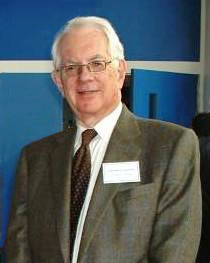Sheldon Glashow facts for kids
Quick facts for kids
Sheldon Glashow
|
|
|---|---|

Glashow at Harvard in 2011
|
|
| Born | December 5, 1932 New York City, New York, U.S.
|
| Alma mater | Cornell University (AB, 1954) Harvard University (PhD, 1959) |
| Known for | Electroweak theory Georgi–Glashow model GIM mechanism Glashow resonance De Rujula-Georgi-Glashow quark model Chiral color Very special relativity Trinification Weak hypercharge Weak mixing angle Criticism of Superstring theory |
| Spouse(s) |
Joan Shirley Alexander
(m. 1972) |
| Children | 4 |
| Awards | Oskar Klein Memorial Lecture (2017) Richtmyer Memorial Award (1994) Nobel Prize in Physics (1979) J. Robert Oppenheimer Memorial Prize (1977) Sloan Fellowship (1962) |
| Scientific career | |
| Fields | Theoretical Physics |
| Institutions | Boston University Harvard University Texas A&M University California Institute of Technology Stanford University University of California, Berkeley |
| Thesis | The vector meson in elementary particle decays (1958) |
| Doctoral advisor | Julian Schwinger |
Sheldon Lee Glashow (born December 5, 1932) is an American theoretical physicist. He won the Nobel Prize in Physics in 1979. A theoretical physicist uses math and models to understand how the universe works.
Glashow has taught at many universities. These include Boston University and Harvard University. He is also part of the board for the Bulletin of the Atomic Scientists. This group focuses on global security issues.
Contents
Early Life and Education
Sheldon Glashow was born in New York City on December 5, 1932. His parents were Jewish immigrants from Russia. His father, Lewis Gluchovsky, was a plumber.
High School and College Years
Glashow graduated from Bronx High School of Science in 1950. He was in the same class as Steven Weinberg. Years later, Glashow, Weinberg, and Abdus Salam would share the Nobel Prize in Physics.
Sheldon Glashow earned his first degree from Cornell University in 1954. He then received his PhD in physics from Harvard University in 1959. His advisor was the famous physicist Julian Schwinger.
Teaching and Research Career
After his studies, Glashow worked at several top universities. He was a research fellow at the California Institute of Technology. He also taught at Stanford University and the University of California, Berkeley.
In 1966, he joined the physics department at Harvard University. He became a professor there and later an emeritus professor in 2000. Glashow has also been a visiting scientist at CERN in Europe. He has taught at MIT and Boston University, among others.
Important Discoveries in Physics
Sheldon Glashow is known for his work on how tiny particles interact. His research helped create the "Standard Model" of particle physics. This model explains the basic forces and particles in the universe.
Electroweak Theory
In 1961, Glashow expanded on ideas about how two forces, the electromagnetic and weak forces, are connected. He suggested a new particle, the Z0 boson. This particle helps explain how these forces work together.
His idea, called the electroweak theory, is a key part of modern physics. For this important discovery, Glashow shared the 1979 Nobel Prize in Physics. He shared it with Steven Weinberg and Abdus Salam.
Predicting the Charm Quark
In 1964, Glashow and James Bjorken made another big prediction. They were the first to suggest there was a fourth type of quark, called the charm quark. At that time, scientists knew about three quarks and four lepton particles.
Their later work in 1970, called the GIM mechanism, showed why the charm quark was needed. It helped explain why certain particle changes were rarely seen. The prediction of the charm quark also solved a problem in quantum field theory.
Grand Unified Theory
In 1973, Glashow and Howard Georgi proposed the first "grand unified theory." This theory tried to combine the strong, weak, and electromagnetic forces into one single framework. They showed how these forces could fit together mathematically.
Their work suggested that protons might not be completely stable. This was a new and exciting idea. This theory laid the groundwork for future attempts to unify all the forces of nature.
Personal Life
Sheldon Glashow is married to Joan Shirley Alexander. They have four children. His wife's sister was the famous scientist Lynn Margulis. This made Carl Sagan his former brother-in-law.
Glashow has described himself as an "atheist," meaning he does not believe in a god. He is also a supporter of the Democratic political party.
In 2008, Glashow and 19 other Nobel Prize winners signed a letter. They asked President George W. Bush to provide more funding for science research. They wanted to support important scientific agencies in the U.S.
Books and Publications
Sheldon Glashow has written several books about physics for a wider audience:
- The Charm of Physics (1991)
- From Alchemy to Quarks: The Study of Physics as a Liberal Art (1994)
- Interactions: A Journey Through the Mind of a Particle Physicist and the Matter of this World (1988)
He also co-edited several scientific workshops and contributed to other books.
Awards and Honors
Sheldon Glashow has received many awards for his contributions to physics:
- J. Robert Oppenheimer Memorial Prize (1977)
- Nobel Prize in Physics (1979)
- Golden Plate Award of the American Academy of Achievement (1980)
- Member of the American Philosophical Society (2002)
See also
 In Spanish: Sheldon Lee Glashow para niños
In Spanish: Sheldon Lee Glashow para niños
- Neutral current
- Weak hypercharge
- List of Jewish Nobel laureates

